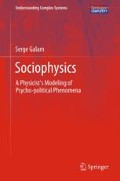Abstract
Dealing with terrorism is extremely delicate. Too much sorrow, passion, hate, and death are at stake. But that should not prevent us from trying to model the issue to try to single out its bare mechanisms and to eventually be able to curb its destructive capacity. The use of equations combined with what could look a priori like a simplistic viewpoint, but in fact is inspired from the physics of disorder, may indeed provide a new insight, which could eventually open unexpected paths to help in reducing terrorism. Any improvement is urged and should be welcomed. But modeling does not mean discovering the one and only “truth”. The problem is multi-fold, difficult, complex, emotional, and operated by archaic passions. This is precisely why the use of “nonhuman” frames and concepts could turn out to be quite productive in providing us with a different paradigm for encompassing the phenomenon, which may lead to useful solid steps in curbing terrorism.
Access this chapter
Tax calculation will be finalised at checkout
Purchases are for personal use only
References
D. Stauffer and A. Aharony, “Introduction to percolation theory” Taylor and Francis, London (1994)
S. Galam, “The September 11 attack: A percolation of individual passive support”, Eur. Phys. J. B 26 Rapid Note, 269–272 (2002)
S. Galam, “La détection des réseaux terroristes”, Stratégie et décision: La crise du 11 septembre, General Loup Francart et Isabelle Dufour, Economica, Paris (2002)
S. Galam, “Global physics: from percolation to terrorism,: guerilla warfare and clandestine activities”, Physica A 330, 139–149 (2003)
S. Galam, “Terrorisme et percolation”, Pour La Science 306, 90–93, Avril (2003)
S. Galam and A. Mauger, “On reducing terrorism power: a hint from physics”, Physica A 323, 695–704 (2003)
S. Galam and A. Mauger, “Universal formula for percolation thresholds”, Phys. Rev. E 53, 2177–2181, (1996)
K. Malarz and S. Galam, “Square-lattice site percolation at increasing ranges of neighbor bonds”, Phys. Rev. E 71, 016125-1-4 (2005)
S. Galam, “Global terrorism versus social permeability to underground activities”, in Econophysics and Sociophysics: Trends and Perspectives, B. K. Chakrabarti, A. Chakraborti, A. Chatterjee (Eds.), Chap. 14, Wiley-VCH Verlag GmbH & Co. KGaA: Weinheim (2006)
S. Galam and A. Mauger, “On reducing terrorism power: a hint from physics”, Physica A 323, 695–704 (2003)
Author information
Authors and Affiliations
Rights and permissions
Copyright information
© 2012 Springer Science+Business Media, LLC
About this chapter
Cite this chapter
Galam, S. (2012). Terrorism and the Percolation of Passive Supporters. In: Sociophysics. Understanding Complex Systems. Springer, Boston, MA. https://doi.org/10.1007/978-1-4614-2032-3_9
Download citation
DOI: https://doi.org/10.1007/978-1-4614-2032-3_9
Published:
Publisher Name: Springer, Boston, MA
Print ISBN: 978-1-4614-2031-6
Online ISBN: 978-1-4614-2032-3
eBook Packages: Humanities, Social Sciences and LawSocial Sciences (R0)

